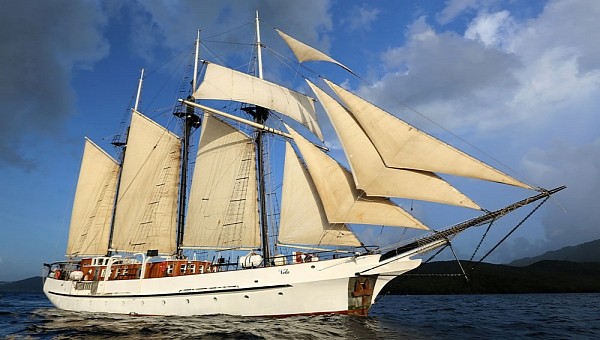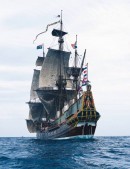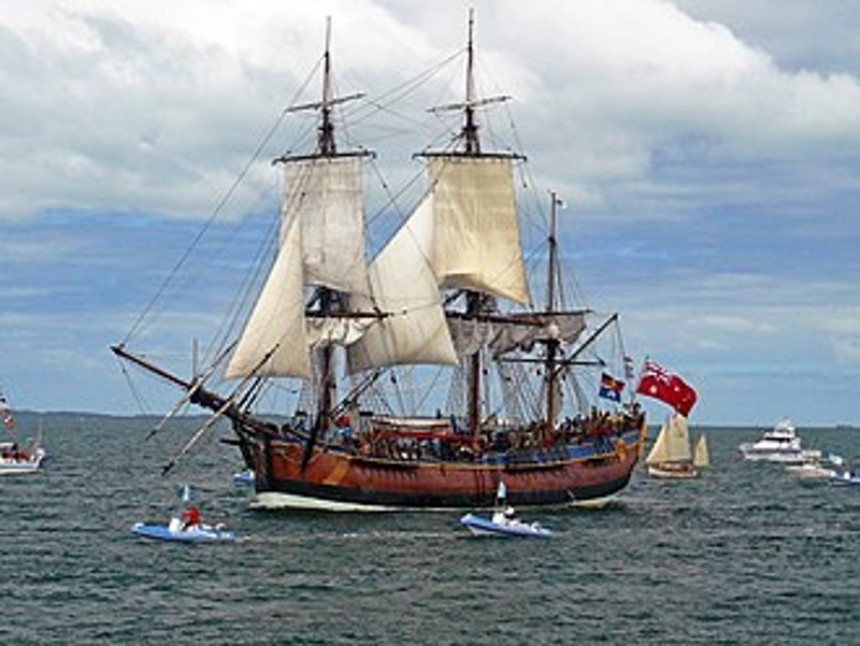Just as the automotive world has different styles of vehicles in the form of sports cars, coupes, sedans, station wagons, vans, SUVs, and others, so too does the sailboat industry.
We are going to take a look at some of the more popular vessels throughout the Age of Sails that began to die in the mid-19th century; back then, there were barques, brigs, cutters, schooners, and retourschips, among others.
Barques (sometimes spelled 'bark') date back to the early 18th century and were relatively small sailing vessels with three or more masts, all of which were square-rigged except for the aft-most one, which had a boom and was rigged both fore and aft. Square-rigged refers to a vessel where the primary sails are rigged to horizontal spars, known as yardarms, that are perpendicular to a vessel's keel to the masts.
Pirates would often say that the most appropriate time to begin drinking was when the sun was over the yardarm.
Brigs were common sites along the British coast in the late 1700s as coal-carrying vessels. This type of sailing ship had two masts, with the aft one acting as the main mast having three square-rigged sails and a fore and aft sail to improve maneuverability. Brigs also had up to three headsails that extended out over an elongated bowsprit and varied in size from 75 and 165 feet (23 and 50 meters)
Cutters were introduced in the late 18th century and closely resemble the modern-day sloop that utilizes just a single mast with either gaff-rigged (refers to a sail with four corners that is controlled at its peak by a spar known as a 'gaff') or square-rigged sails in addition to two or more headsails and a brig-like bowsprit. Cutters were built for speed and relied on simple rigging for maximum sail area.
Clippers began appearing in the mid-19th century and were outfitted with an astounding amount of sail area for speed in running tea from China to Europe. Some, known as 'Opium Clippers,' were built specifically for the opium trade between India and China. Clippers could be rigged as brigs or schooners depending on their intended use.
Schooners were sailing vessels defined by their rigging. With two or more masts fore and aft rigged, they were used extensively in coastal trade in eastern North America. A two-masted schooner typically had a foremast that was shorter than the main mast. A topsail schooner can be identified by having a square-rigged topsail on the foremast. Bermuda schooners were those with more modern triangular sails you see on most sailboats today. While they were primarily used for hauling bulk cargoes of lumber and coal, these speedy vessels also dominated the early years of the America's Cup.
Retourschip vessels were the work of the United East India Company or VOC (Dutch: Verenigde Oostindische Compagnie) and were used primarily as trade ships plying the waters between Europe and Asia. They were massive ships with huge cargo holds. They were distinguished by the large bulge at the stern of the ship that was often the quarters of the ship's captain. These ships would later become the blueprint for pirate ships. The most famous VOC was the Amsterdam which was 48 meters (157 feet) in length, displaced 1,100 tons, and was fully equipped with an armament of cannons and swivel guns. A replica of the Amsterdam was built and launched by the city in 1989.
Windjammers were commercial sailing vessels that were either square-rigged or fore-and-aft-rigged with multiple masts and a pronounced bowsprit. They were primarily used on long voyages and would later resurface as cruise ships in the waters of the Caribbean. The term 'windjammer' came just as the shipping world began opting from sail to steam; some say that the sound of strong winds blowing through the rigging of these vessels was the source of the moniker. However, the most popular train of thought is that because of the expanse of the sails, they seemed to 'jam' the wind. Others would go on to believe the name was derived from the fact that these vessels could not sail into the wind very effectively because of their square rigging and therefore had to jam their way along.
So there you have it, a brief description of the sailing ships of yesteryear to give you some idea of their characteristics and purposes. Some of the features of those early vessels are still applied to today's watercraft, while others have blown away in the wind in favor of simplicity and efficiency.
Barques (sometimes spelled 'bark') date back to the early 18th century and were relatively small sailing vessels with three or more masts, all of which were square-rigged except for the aft-most one, which had a boom and was rigged both fore and aft. Square-rigged refers to a vessel where the primary sails are rigged to horizontal spars, known as yardarms, that are perpendicular to a vessel's keel to the masts.
Pirates would often say that the most appropriate time to begin drinking was when the sun was over the yardarm.
Brigs were common sites along the British coast in the late 1700s as coal-carrying vessels. This type of sailing ship had two masts, with the aft one acting as the main mast having three square-rigged sails and a fore and aft sail to improve maneuverability. Brigs also had up to three headsails that extended out over an elongated bowsprit and varied in size from 75 and 165 feet (23 and 50 meters)
Clippers began appearing in the mid-19th century and were outfitted with an astounding amount of sail area for speed in running tea from China to Europe. Some, known as 'Opium Clippers,' were built specifically for the opium trade between India and China. Clippers could be rigged as brigs or schooners depending on their intended use.
Schooners were sailing vessels defined by their rigging. With two or more masts fore and aft rigged, they were used extensively in coastal trade in eastern North America. A two-masted schooner typically had a foremast that was shorter than the main mast. A topsail schooner can be identified by having a square-rigged topsail on the foremast. Bermuda schooners were those with more modern triangular sails you see on most sailboats today. While they were primarily used for hauling bulk cargoes of lumber and coal, these speedy vessels also dominated the early years of the America's Cup.
Retourschip vessels were the work of the United East India Company or VOC (Dutch: Verenigde Oostindische Compagnie) and were used primarily as trade ships plying the waters between Europe and Asia. They were massive ships with huge cargo holds. They were distinguished by the large bulge at the stern of the ship that was often the quarters of the ship's captain. These ships would later become the blueprint for pirate ships. The most famous VOC was the Amsterdam which was 48 meters (157 feet) in length, displaced 1,100 tons, and was fully equipped with an armament of cannons and swivel guns. A replica of the Amsterdam was built and launched by the city in 1989.
So there you have it, a brief description of the sailing ships of yesteryear to give you some idea of their characteristics and purposes. Some of the features of those early vessels are still applied to today's watercraft, while others have blown away in the wind in favor of simplicity and efficiency.







